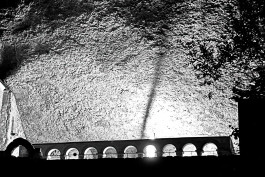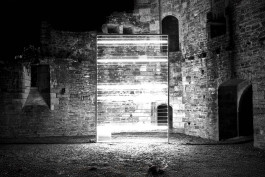
Genealogy of Fire
Intervention in an archaeological site: Old Monastery of San Juan de la Peña / Aragonese Pyrenees. Created within the framework of the Nomadic Borders project. Curated by Blanca Pérez Ferrer and Jean Jacques Gay.
Dimensions: 290 x 440 cm.
Technique: Electronics, programming, sound.
–
2021
Description of the project
The project involved the intervention in three archaeological sites through a light installation, a large-format electronic artwork capable of dialoguing with its surroundings and breathing new life into historically rich spaces, symbolically reactivating these spiritual architectures. The use of technology, understood as the “contemporary fire,” allows us to build bridges through time in search of the latent consciousness in these settings that once hosted other fires in the past. Technology, nature, and spirituality come together in this experience, proposing artistic practice as a source of knowledge, a new perspective with which to approach these memory-laden sites.
The Contemporary Fire
The mastery of fire is considered the first step in the technological history of human civilization. In Greek mythology, Prometheus steals fire from the gods to give it to humans, thus initiating a process that ultimately leads to the mastery of technique and scientific knowledge. Fire is the mythological origin of technology, and in our contemporary times, this fire is electricity harnessed by electronics and computing.

Poetics of the media
Just as fire plays with wood in a bonfire, computer code dances in silicon cells, creating unpredictable patterns. Deserts of transistors are saturated by oceans of electrons in quantum universes. Information, riding the electric serpent, intertwines to burst into unpredictable flashes of light. Zeros and ones drive the movement in the computational cabal. Processes follow one another in search of a perpetually redefining balance. Order and chaos struggle in an irresolvable process that makes its way through thousands of light-emitting diodes.










Genealogía del fuego. Francia. 2021
Genealogía del fuego. Francia. 2021
Genealogía del fuego. Francia. 2021
Genealogía del fuego. Francia. 2021
Genealogía del fuego. Francia. 2021
Genealogía del fuego. Francia. 2021
Genealogía del fuego. Francia. 2021
Genealogía del fuego. Francia. 2021
Genealogía del fuego. Francia. 2021
Genealogía del fuego. Francia. 2021
Historical Framework
Around the year 1000, the project of building Europe as a political and religious community in the image and likeness of the Sacrum Romanum Imperium began to take shape, originally driven by the constructive faith of Charlemagne in close collaboration with Rome. Leveraging the prestige of those men and women who had taken the path of spiritual retreat to achieve enlightenment, the apartheia, and who were considered saints and sages by their countrymen, a top-down unification project was initiated among kings, counts, and bishops. They began integrating popular religiosity into Roman tradition and ritual. The end of the 10th century saw the proliferation of monastic foundations in the county of Gascony, driven by the founding of Cluny and the expansion of the Rule of Saint Benedict, as exemplified by the Abbey of Saint-Vincent de Lucq in Béarn. According to tradition, when Childebert I returned from the siege of Zaragoza in 542, one of his lieutenants founded an oratory dedicated to Saint Vincent in Lucq. Thus, the monastery was dedicated to Saint Vincent.
The Benedictine reform was introduced by Sancho the Great in the 1030s at San Juan de la Peña, which was already an important monastic center thanks to donations from the Aragonese counts and Navarrese kings and the establishment of an almonry. Further south, the Royal Monastery of Rueda is situated on the banks of the Ebro River in Zaragoza province, Spain. It is an architectural gem of the Cistercian order, founded in the 12th century during the reign of Alfonso II of Aragon. This order, derived from the Benedictines, was characterized by its rigor and austerity, seeking a return to primitive monastic life and strict observance of the Rule of Saint Benedict. The monastery is notable for its impressive waterwheel, which supplied water to the complex and its lands, symbolizing the engineering prowess and self-sufficiency of the Cistercian community.
Locations

The mastery of fire is perhaps the first step in the technological history of human civilisation.
In Greek mythology, Prometheus steals fire from the gods to give it to men and thus begins a process that eventually leads to the mastery of technology and scientific knowledge.
Fire is the mythological origin of technology and in our contemporaneity, this fire is electricity riding on the back of electronics and computers. Just as fire plays with wood at the stake, computer code dances in silicon cells building unpredictable patterns. Deserts of transistors are saturated by oceans of electrons in quantum universes. Information, on the back of the electrical snake, intertwines to burst into unpredictable clicks of light. Zeros and ones force movement in the computational cabal. Processes continue each other in search of an ever-defining equilibrium. Order and chaos struggle in an irresolvable process that winds its way through thousands of light-emitting diodes.
nestorlizalde@gmail.com
+34 659 751 761
© 2024
↑
nestorlizalde@gmail.com
+34 659 751 761
© 2024
↑